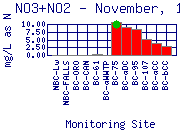 |
|
 |
|
 Nitrite+nitrate concentrations and ammonia concentrations are usually low or undetectable in the upper part of Boulder Creek.
Nitrite+nitrate concentrations and ammonia concentrations are usually low or undetectable in the upper part of Boulder Creek.
 Concentrations of nitrate+nitrite and ammonia increase significantly at sampling site BC-75, due to outfall from the Boulder Wastewater Treatment Plant (WWTP).
The City of Boulder meets discharge requirements of the Colorado Department of Public Health and Environment, but some nitrate+nitrite and ammonia remain in the effluent.
Concentrations downstream from the WWTP generally decrease due to dilution (as in November 1999).
Concentrations of nitrate+nitrite and ammonia increase significantly at sampling site BC-75, due to outfall from the Boulder Wastewater Treatment Plant (WWTP).
The City of Boulder meets discharge requirements of the Colorado Department of Public Health and Environment, but some nitrate+nitrite and ammonia remain in the effluent.
Concentrations downstream from the WWTP generally decrease due to dilution (as in November 1999).
 However, in some months (such as September and October 1998), nitrite and nitrate concentrations spike at sampling sites BC-aDC and/or BC-95.
These spikes may be due to non-point sources such as fertilizers or animal waste.
However, in some months (such as September and October 1998), nitrite and nitrate concentrations spike at sampling sites BC-aDC and/or BC-95.
These spikes may be due to non-point sources such as fertilizers or animal waste.
The flow rate of Boulder Creek largely influences nitrate+nitrite and ammonia concentrations in Boulder Creek. From April to September, flow in Boulder Creek is higher due to snowmelt runoff and thunderstorms (see 1998 discharge rate at BC-75).
The high volume of water dilutes nitrite+nitrate and ammonia concentrations in the creek.
 During low-flow months, wastewater effluent discharged from the WWTP dominates stream flow in lower Boulder Creek, often comprising over half of the total flow.
Therefore, nitrate+nitrite and ammonia concentrations are often higher in low-flow months such as November, December, January, February, and March (for example, see BC-aDC in 1999 included here on the right).
During low-flow months, wastewater effluent discharged from the WWTP dominates stream flow in lower Boulder Creek, often comprising over half of the total flow.
Therefore, nitrate+nitrite and ammonia concentrations are often higher in low-flow months such as November, December, January, February, and March (for example, see BC-aDC in 1999 included here on the right).
COMPARISON TO REGULATIONS
Nitrate+Nitrite
Colorado Department of Public Health and Environment Water Quality Control Division (CDPHE-WQCD) regulations (5 CCR 1002-31) state that for domestic water supply, the combined total of nitrite and nitrate shall not exceed 10 mg/L as N and nitrite concentration shall not exceed 1 mg/L as N at the point of intake (that is, the location where water enters standard treatment for drinking water). Nitrate+nitrite concentrations in upper Boulder Creek were always well below 1 mg/L (as N) in 1998 and 1999; nitrate+nitrite concentrations in lower Boulder Creek were significantly higher, with two concentrations above 10 mg/L recorded at site BC-75 in 1998 and 1999.
CDPHE-WQCD regulations for aquatic life do not give a maximum concentration for nitrate. Maximum concentrations of nitrite allowed for Class 1 Aquatic Life water depend on whether salmonids (such as trout) and other sensitive fish species are present and on chloride concentration in the water. Nitrite concentrations for Boulder Creek will be included for this data set shortly.
CDPHE-WQCD regulations state that for agriculture water, the combined total of nitrite and nitrate shall not exceed 100 mg/L (as N), and the nitrite concentration shall not exceed 10 mg/L (as N). These values were never exceeded in the Boulder Creek samples analyzed in 1998 and 1999.
For more information on these regulations, see http://www.cdphe.state.co.us/cdphereg.asp#wqreg.
Ammonia
CDPHE-WQCD regulations state that for domestic water supply, chronic total ammonia concentrations shall not exceed 0.5 mg/L as N at the point of intake (that is, ammonia concentrations should not exceed 0.5 mg/L constantly over a 30-day period at the location where water enters standard treatment for drinking water). Ammonia concentrations in upper Boulder Creek were always below 0.5 mg/L (as N) in 1998 and 1999; ammonia concentrations in lower Boulder Creek were significantly higher, with a maximum of 17 mg/L (as N) at BC-75 in February 1998.
CDPHE-WQCD regulations for Aquatic Life are based on unionized (no electrical charge) ammonia (NH3). However, the Boulder Creek samples are analyzed for total ammonia (which includes unionized ammonia and the ionized ammonium ion (NH4+)). The percentage of unionized ammonia can be calculated from the total ammonia concentration on a case by case basis, with a formula that factors in temperature and pH of the water being analyzed. This calculation has been performed for Boulder Creek samples in the past. At times during late summer, when flow rates are low, and stream temperature and pH are very high, unionized ammonia concentrations in Boulder Creek downstream from the Wastewater Treatment Plant sometimes exceed maximum concentrations. However, these concentrations are not chronic (that is, unionized concentrations are not constantly above the maximum concentration for 30 days).
For more information on these regulations, see http://www.cdphe.state.co.us/cdphereg.asp#wqreg.